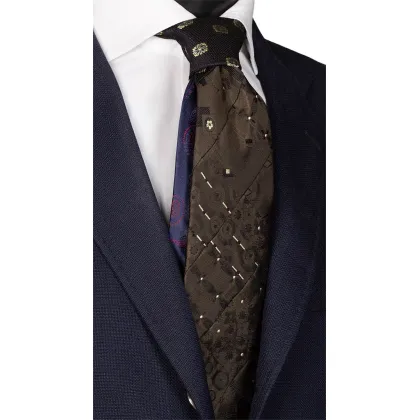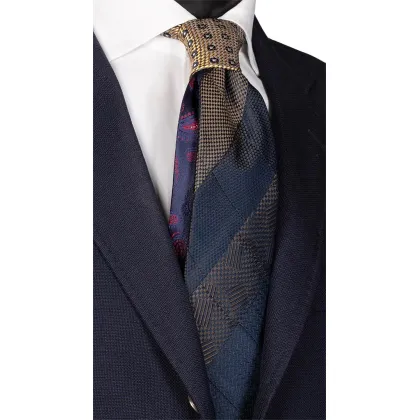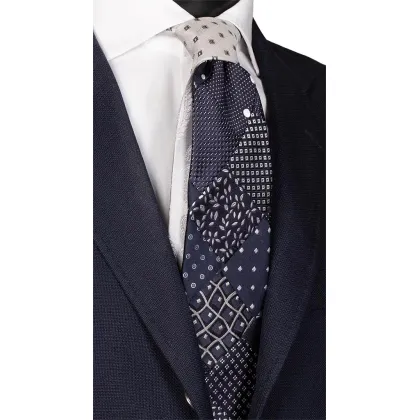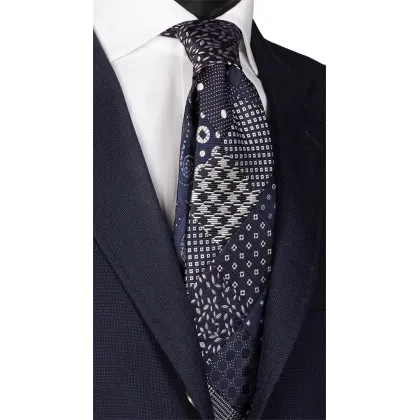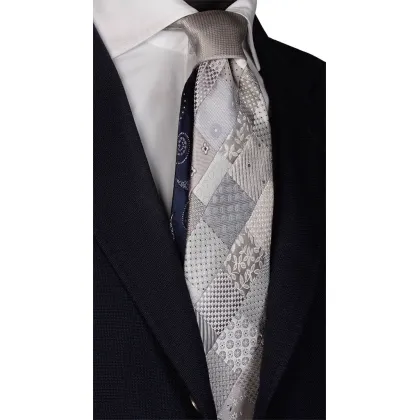Patchwork ties
-
Unique ties from Italy
€365.00 -
Beautiful ties from Italy
€365.00 -
Elegant ties from Italy
€456.00 -
Stylish ties from Italy
€456.00 -
Unique ties from Italy
€549.00
Men's Patchwork Ties – The Perfect Gift for a Man
The earliest forms of patchwork originated in England, before the Victorian era. They were a method of clothing repair necessitated by extreme poverty. People sought ways to mend clothes, patching holes, tears, or wear and tear. Few could afford new clothes, so they used leftover materials. Even the smallest scraps, which were no longer suitable for reuse, were cut out to create patches.
From larger pieces, after sewing, one could create children's clothing or accessories such as patchwork ties or scarves. They were also combined with flour or potato sacks, resulting in clothing for the elderly. It can be said that the impoverished community of Great Britain, over 300 years ago, practiced large-scale recycling. Thanks to patchwork, people could save money for basic family maintenance while always looking neat.
Patchwork – From Poverty to Luxury
Originally, patchwork was driven by the poverty of the English community. However, in the Victorian era, this method found its way into bourgeois homes and underwent a transformation. Its potential was recognized, and over the years it became a form of exclusive, artistic sewing, adopted by the world's leading designers of luxury clothing and accessories, including patchwork ties. By the 19th century, urban women were using various stitching techniques, as well as embellishments like ruffles, sewn-on ribbons, appliqués, buttons, and coral beads.
When discussing patchwork, one must also mention a form that likely appeared long before the British version, namely quilting. This is patchwork combined with quilting. It most likely arrived in Europe from Eastern countries. Considering the oldest quilt found in 1924, it is estimated to date back to the late 12th century.
Contemporary Patchwork Tie as a Symbol of Elegance and Luxury
It features interesting and sophisticated designs. It is a form of luxury that highlights the social status of the wearer, such as a patchwork tie. Currently, it is characterized by original ornamentation and decorative stitching. Products made using this method are sewn by hand or machine, but always with the utmost care and attention to even the smallest details. This is why ties made using patchwork or quilting, clothing, or home interior accessories are highly sought after. Today, it is not just a sewing method but a great art form.
Shakespeare's famous English writer's wife was reportedly enamored with quilting and patchwork. In the 21st century, many renowned fashion designers share similar sentiments, and the sewing method regularly appears on the front pages of fashion magazines. Luxury and elegance of patchwork are utilized in the projects of brands such as Christian Dior, Harry Style, and Alexander McQueen.
Branded Patchwork Ties for the Elegant Man
One of the biggest fashion hits in recent years is patchwork ties. They give men not only an elegant look but also exclusivity and a sense of luxury. Hand-sewn, finished with decorative stitching, they guarantee uniqueness and originality. Many traditional tailors make only single pieces. They use fabric scraps with various patterns, geometric shapes, and sizes.
Exclusive fashion houses also apply quilt ornamentation on solid pieces of fabric intended for patchwork ties. Such men's accessories highlight a man's appreciation for high-quality clothing and gadgets, which is associated with their refined taste, need for aesthetics, and elegance. It can be said that a man in a tie made using patchwork or quilting is considered a "good catch," not only as a husband but also as a business partner or contractor.

